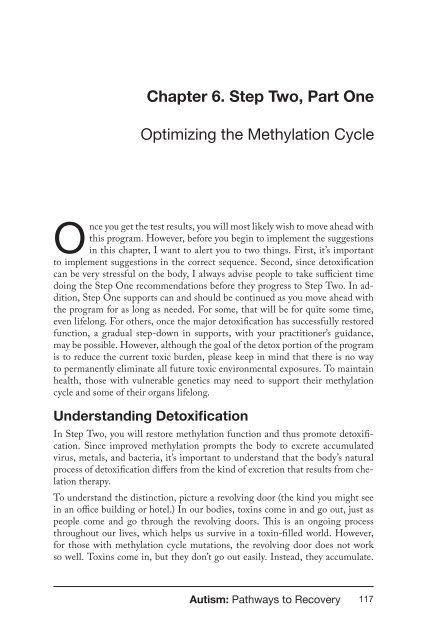3dT4E4Rnm
3dT4E4Rnm
3dT4E4Rnm
You also want an ePaper? Increase the reach of your titles
YUMPU automatically turns print PDFs into web optimized ePapers that Google loves.
Chapter 6. Step Two, Part One<br />
Optimizing the Methylation Cycle<br />
Once you get the test results, you will most likely wish to move ahead with<br />
this program. However, before you begin to implement the suggestions<br />
in this chapter, I want to alert you to two things. First, it’s important<br />
to implement suggestions in the correct sequence. Second, since detoxification<br />
can be very stressful on the body, I always advise people to take sufficient time<br />
doing the Step One recommendations before they progress to Step Two. In addition,<br />
Step One supports can and should be continued as you move ahead with<br />
the program for as long as needed. For some, that will be for quite some time,<br />
even lifelong. For others, once the major detoxification has successfully restored<br />
function, a gradual step-down in supports, with your practitioner’s guidance,<br />
may be possible. However, although the goal of the detox portion of the program<br />
is to reduce the current toxic burden, please keep in mind that there is no way<br />
to permanently eliminate all future toxic environmental exposures. To maintain<br />
health, those with vulnerable genetics may need to support their methylation<br />
cycle and some of their organs lifelong.<br />
Understanding Detoxification<br />
In Step Two, you will restore methylation function and thus promote detoxification.<br />
Since improved methylation prompts the body to excrete accumulated<br />
virus, metals, and bacteria, it’s important to understand that the body’s natural<br />
process of detoxification differs from the kind of excretion that results from chelation<br />
therapy.<br />
To understand the distinction, picture a revolving door (the kind you might see<br />
in an office building or hotel.) In our bodies, toxins come in and go out, just as<br />
people come and go through the revolving doors. This is an ongoing process<br />
throughout our lives, which helps us survive in a toxin-filled world. However,<br />
for those with methylation cycle mutations, the revolving door does not work<br />
so well. Toxins come in, but they don’t go out easily. Instead, they accumulate.<br />
Autism: Pathways to Recovery<br />
117


